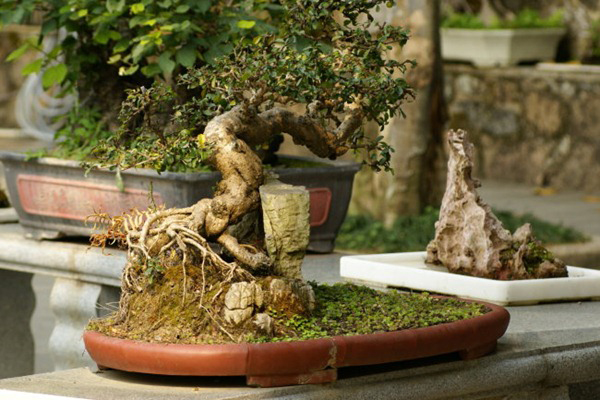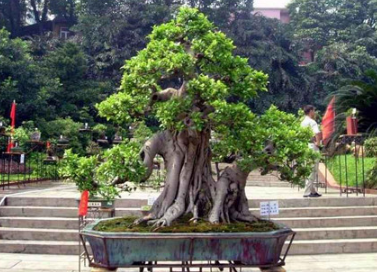How to make banyan bonsai with stone?
The banyan tree has developed roots, soft roots and long roots, so it is a good material for making stone-attached bonsai. In the production of stone bonsai, choose mature, good artistic shape, long enough roots of the banyan stump, in order to create a reasonable sense of movement, but also make the stem have a sense of strength.
Choose many cracks, good posture, it is best to be independent, high ornamental value of stone, such as seaweed stone, Yingde stone, sand stone, Reed stone, stalactite, axe split stone and so on.
For the banyan tree selected as the bonsai with stone, the stump should be removed from the soil during the plum rain season and put on the basin after the bare root is attached to the stone.
The specific method of putting on the basin is: first, the selected stone is fixed at the bottom with cement mortar, and the supporting surface of the stone is increased to help fix the stone at the bottom of the basin. Turn the selected stump or shaped stump out of the basin, remove all the soil, straighten out the long roots, and cut off the useless fibrous roots and redundant branches. According to the conception of the combination of tree and stone, the art form of stone bonsai is expressed reasonably. The root is embedded in the crack of the stone, passes through the cave, and the root is tied and fixed with fine hemp rope, so that the root is tightly attached to the stone. Place stones and trees in bonsai pots or culture pots and fill them with culture soil. The bare part of the tree root on the basin stone is covered with plastic film or a sleeve made of hard paper and thin wood, then filled with culture soil, and then covered with stone and root. After planting in the basin, pour water once, put it in a semi-shady place, and then water and spray the basin soil according to the dry and wet condition of the basin soil to keep the basin soil moist. The sun can be seen after 10 days, and routine fertilizer and water management will be carried out. Should pay attention to the root maintenance, avoid bruising, sunburn roots, so as not to cause local defects. After half a year of growth period culture, the root attached stone is basically fixed.
The shape of banyan bonsai with stone is common in cliff style and boulder style. The upright height of the stone is 30cm to 50cm, some as high as 80cm. The tree species are located at 2 stroke 3 away from the basin, or on the top of the stone. The tree trunk drooped and floated down. Stone bonsai can be made into miniature bonsai or more than 1 meter; GE's large bonsai. Make full use of local stone to make all kinds of stone bonsai.
In boulder bonsai, the stone is short and high. Plant the root on the stone and let the root hold the stone tightly. The root of the dwarf stone forms a claw-shaped tree or a curved, oblique, erect tree to increase the strength of the base. The high stone is thin and steep, but the stone base should be slightly larger, and pay attention to the smooth trend of the tree direction and roots. The trees on the stone are sturdy and sturdy, and they treat the stone as dry and behave as steadily as Mount Tai. Both should reflect the natural beauty of the root, and pay attention to the shape of the tree and the perfection of the stone.
In the dependent stone bonsai, the trunk is dependent on the stone, the root grows at the base of the stone, the trunk half holds the stone, the top of the tree is separated from the top of the stone, so that the stone dew peak, the tree sees the top, and the trend of the tree potential, stone potential and root should be unified to show the overall effect.
How to make banyan bonsai with stone

Bonsai production of banyan tree with stone: material selection
Choose more gaps, good posture, relatively independent ornamental stone, such as seaweed stone, stalactite, axe split stone, Yingde stone and so on.
Select the banyan plant, take it off the pot, remove the soil, and put the bare root on the pot.
Banyan tree with stone bonsai production: upper basin
Fix the selected stone to the bottom of the basin with cement or glue.
Take off the selected banyan tree, remove the soil, and cut off the excess roots.
The root system of the banyan tree is embedded in the gap of the stone, and the root system is fixed with the stone with hemp rope, so that the root is closely combined with the stone.
Fill the soil in the flowerpot, the root system that can not be covered by the surface of the pot soil, can be covered with plastic film, hard paper and then cover the soil.
After planting, pour water thoroughly, wet the stone, put it in a semi-shady place, and replenish water according to the dry and wet condition of the basin soil. After 10 days, move to the sun for normal maintenance. Be careful not to bruise or sunburn the exposed roots, causing local defects. Almost half a year, stone bonsai can be stereotyped.
Banyan tree with stone bonsai: modeling
Cliff style: stand upright with the stone in the basin, plant the banyan tree in 3 places away from the basin, or plant it directly at the top of the stone, with the trunk drooping and drifting.
Boulder style: the stone is high and low, so that the roots hold the stone tightly. The tall stone is thinner and steeper, the short stone is stout, and the branches on the stone are as sturdy as Mount Tai. The two depend on each other, reflecting the natural beauty of the root.
How to make bonsai with banyan tree and stone?
How to make bonsai with banyan tree and stone?
The banyan tree has developed roots, soft roots and long roots, so it is a good material for making stone-attached bonsai. In the production of stone bonsai, choose mature, good artistic shape, enough school roots of the banyan stump, in order to create a reasonable sense of movement, but also make the stem have a sense of strength. Choose many cracks, good posture, it is best to be independent, high ornamental value of stone, such as seaweed stone, Yingde stone, sand stone, Reed stone, stalactite, axe split stone and so on.
For the banyan tree selected as the bonsai with stone, the stump should be removed during the rainy season and put on the basin after the bare root is attached to the stone.
The specific method of putting on the basin is to first select the stone, fix the bottom with cement mortar, and add the supporting surface of the stone, so as to fix the stone at the bottom of the basin. Turn the selected tree stump or shaped stump out of the basin, remove all the soil, straighten out the long roots, and cut off the useless fibrous roots and excess branches. According to the meditation of the combination of tree and stone, reasonably express the art form of bonsai with stone, inlay the root in the crack of the stone, walk through the cave, and fasten the root with fine hemp rope, so that the root is tightly attached to the stone. Place stones and trees in bonsai pots or culture pots and fill them with culture soil. The exposed part of the tree root on the basin stone is covered with plastic film or a sleeve made of hard paper and thin wood, then filled with culture soil, and then covered with stone and root. After planting in the basin, pour water once, put it in a semi-shady place, and then water and spray the basin soil according to the dry and wet condition of the basin soil to keep the basin soil moist. The sun can be seen after 10 days, and routine fertilizer and water management will be carried out. Should pay attention to the root maintenance, avoid bruising, sunburn roots, so as not to cause local defects. After half a year of growth period culture, the root attached stone is basically fixed.
The shape of banyan bonsai with stone is common in cliff style and boulder style. The upright height of the stone is SO~50 cm, some as high as 80 cm. The tree species are located at 2 stroke or 3 places away from the basin, or the tree is on the top of the stone, and the trunk is drooping to float down. Stone-attached bonsai can be made into miniature bonsai or large-scale bonsai more than 1 meter high, which can make full use of local stone materials to make all kinds of stone-attached bonsai.
In boulder bonsai, the stone is short and high. Plant the root on the stone and let the root hold the stone tightly. The root of the dwarf stone forms a claw-shaped tree or a curved, oblique, upright tree to strengthen the base. The high stone is thinner and the performance is steep, but the stone base should be slightly larger, pay attention to the trend of the tree to the root should be smooth, the tree on the stone should be short and strong, treat the stone as a stem, the performance is as steady as Mount Tai □, both should reflect the natural beauty of the root, but also pay attention to the shape of the tree and the perfection of the stone. In the dependent stone bonsai, the trunk is dependent on the stone, the root grows at the base of the stone, the trunk half holds the stone, the top of the tree is separated from the top of the stone, so that the stone dew peak, the tree sees the top, and the orientation of the tree potential, stone potential and root should be unified to show the overall effect.
- Prev

How to make hydroponic banyan bonsai?
The banyan tree is a plant that likes to be wet. Most of the banyan trees in nature grow on the banks of ponds and rivers, with one root growing on the bank and one root immersed in water. Many bonsai artists produce excellent hydroponic bonsai according to this characteristic. Hydroponic banyan bonsai has two forms: stone-attached water culture and flat-root water culture. (1) Stone-attached water culture
- Next

What are the characteristics of banyan bonsai?
Banyan is a tropical tree species, distributed in Fujian, Guangdong, Guangxi, Taiwan, Yunnan, Sichuan and other places. It likes light and warmth, adapts to the humid and rainy climate, is slightly shady, but not cold-resistant, and is suitable for fertile, loose and moist alluvial sandy loam. The banyan tree has strong vitality and adaptability, and can be cultivated as a bonsai for a long time.
Related
- Fuxing push coffee new agricultural production and marketing class: lack of small-scale processing plants
- Jujube rice field leisure farm deep ploughing Yilan for five years to create a space for organic food and play
- Nongyu Farm-A trial of organic papaya for brave women with advanced technology
- Four points for attention in the prevention and control of diseases and insect pests of edible fungi
- How to add nutrient solution to Edible Fungi
- Is there any good way to control edible fungus mites?
- Open Inoculation Technology of Edible Fungi
- Is there any clever way to use fertilizer for edible fungus in winter?
- What agents are used to kill the pathogens of edible fungi in the mushroom shed?
- Rapid drying of Edible Fungi

